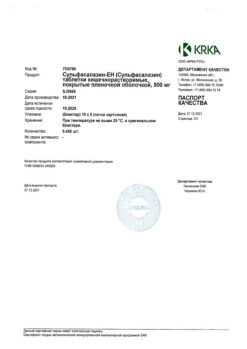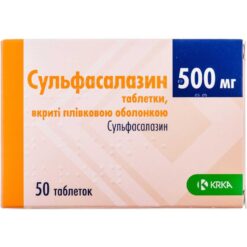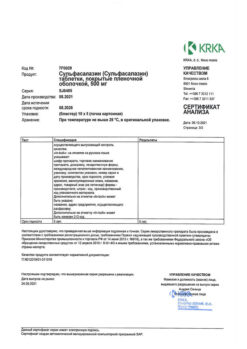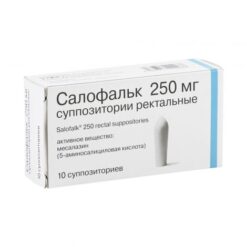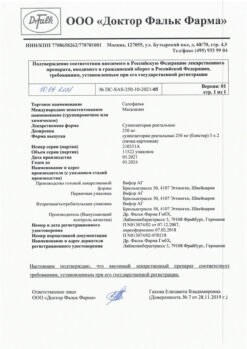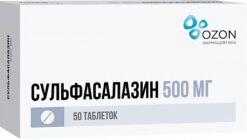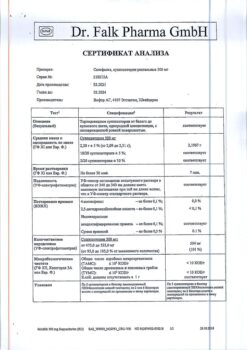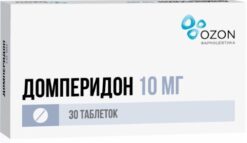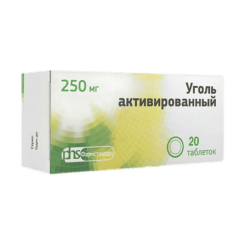No products in the cart.
Urcevel, 250 mg capsules 100 pcs
€42.44 €36.78
Description
Pharmacotherapeutic group: hepatoprotective agent
ATC code: A05AA02
Pharmacological properties
Pharmacodynamics
Hepatoprotective drug, has choleretic effect. It reduces the synthesis of cholesterol in the liver, its absorption in the intestine and its concentration in bile, increases the solubility of cholesterol in the biliary system, stimulates the formation and excretion of bile. It decreases bile lithogenicity and increases bile acids content; it causes intensification of gastric and pancreatic secretion, increases lipase activity and has hypoglycemic effect. Causes partial or complete dissolution of cholesterol stones in enteral administration, reduces bile saturation with cholesterol, which promotes mobilization of cholesterol from gallstones. It has immunomodulatory effects and influences immunological reactions in the liver: it decreases the expression of some antigens on the membrane of hepatocytes, affects the number of T-lymphocytes, interleukin-2 formation, decreases the number of eosinophils.
Pediatric population
Mucoviscidosis (cystic fibrosis)
. According to clinical reports, there is a long history (up to 10 years or more) of treatment with ursodeoxycholic acid in pediatric patients with hepatobiliary disease associated with cystic fibrosis (CFAHD). There is evidence that therapy with ursodeoxycholic acid can decrease bile duct proliferation, slow down the development of lesions detected by histological examination, and even promote reversal of hepatobiliary changes if therapy is started at early stages of CFAHD. In order to optimize treatment efficacy, ursodeoxycholic acid therapy should be initiated as early as possible after the diagnosis of CFAHD.
Pharmacokinetics
After oral administration, ursodeoxycholic acid is rapidly absorbed in the jejunum and proximal ileum by passive diffusion and in the distal ileum by active transport. Approximately 60-80 % of the administered dose is absorbed. After absorption ursodeoxycholic acid almost completely conjugates in the liver with glycine and taurine and is excreted with bile. During the first passage through the liver it is metabolized up to 60%.
Depending on the daily dose, type of disease and liver condition, more or less ursodeoxycholic acid accumulates in the bile. At the same time, there is a relative decrease in other, more lipophilic bile acids.
In the action of intestinal bacteria ursodeoxycholic acid is partially broken down to form 7-keto-lithocholic acid and lithocholic acid. Lithocholic acid is hepatotoxic; in some animal species it causes damage to the liver parenchyma. In humans it is absorbed only in small amounts. During metabolism it is sulfated in the liver, due to which it is neutralized before it is excreted into bile and excreted with feces. The half-life of ursodeoxycholic acid is from 3.5 to 5.8 days.
Indications
Indications
Dissolution of cholesterol gallstones, biliary reflux gastritis, primary biliary cirrhosis in the absence of signs of decompensation, chronic hepatitis of various origins, primary sclerosing cholangitis, cystic fibrosis, non-alcoholic steatohepatitis, alcoholic liver disease, biliary dyskinesia.
Pharmacological effect
Pharmacological effect
Pharmacotherapeutic group: hepatoprotective agent
ATX code: A05AA02
Pharmacological properties
Pharmacodynamics
Hepatoprotective agent, has a choleretic effect. Reduces cholesterol synthesis in the liver, its absorption in the intestines and concentration in bile, increases the solubility of cholesterol in the biliary system, stimulates the formation and secretion of bile. Reduces the lithogenicity of bile, increases the content of bile acids; causes increased gastric and pancreatic secretion, enhances lipase activity, and has a hypoglycemic effect. Causes partial or complete dissolution of cholesterol stones when administered enterally, reduces the saturation of bile with cholesterol, which promotes the mobilization of cholesterol from gallstones. It has an immunomodulatory effect, affects immunological reactions in the liver: it reduces the expression of certain antigens on the hepatocyte membrane, affects the number of T-lymphocytes, the formation of interleukin-2, and reduces the number of eosinophils.
Pediatric population
Cystic fibrosis (cystic fibrosis)
According to clinical reports, there is many years of experience (up to 10 years or more) in treating pediatric patients with cystic fibrosis-associated hepatobiliary disease (CFAHD) with ursodeoxycholic acid. There is evidence that ursodeoxycholic acid therapy can reduce bile duct proliferation, slow the development of lesions detected by histological examination, and even promote the reversal of changes in the hepatobiliary system if therapy is started in the early stages of CFAHD. To optimize treatment efficacy, ursodeoxycholic acid therapy should be initiated as soon as possible after the diagnosis of CFAHD.
Pharmacokinetics
After oral administration, ursodeoxycholic acid is rapidly absorbed in the jejunum and proximal ileum by passive diffusion, and in the distal ileum by active transport. Approximately 60-80% of the dose taken is absorbed. After absorption, ursodeoxycholic acid is almost completely conjugated in the liver with glycine and taurine and excreted in the bile. During the first passage through the liver, up to 60% is metabolized.
Depending on the daily dose, the type of disease and the condition of the liver, more or less amount of ursodeoxycholic acid accumulates in the bile. At the same time, there is a relative decrease in the content of other, more lipophilic bile acids.
Under the influence of intestinal bacteria, ursodeoxycholic acid is partially degraded to form 7-keto-lithocholic and lithocholic acid. Lithocholic acid is hepatotoxic; in some animal species it causes damage to the liver parenchyma. In the human body it is absorbed only in small quantities. During the process of metabolism, it is sulfated in the liver, due to which it is neutralized even before it is excreted into bile and excreted from the body with feces. The half-life of ursodeoxycholic acid is 3.5 to 5.8 days.
Special instructions
Special instructions
Ursodeoxycholic acid should be taken under medical supervision.
During the first 3 months of treatment, liver function parameters should be monitored: transaminases, alkaline phosphatase and gamma-glutamyl transpeptidase in the blood serum every 4 weeks, and then every 3 months. Monitoring these parameters makes it possible to identify liver dysfunction in the early stages. This also applies to patients in the later stages of primary biliary cirrhosis. In addition, it can quickly determine whether a patient with primary biliary cirrhosis is responding to treatment.
When used to dissolve cholesterol gallstones
In order to assess progress in treatment and to promptly identify signs of calcification of stones depending on their size, the gallbladder should be visualized (oral cholecystography) with examination of opacities in the standing and supine position (ultrasound) 6-10 months after the start of treatment.
If the gallbladder cannot be visualized on x-rays or in cases of calcified stones, poor gallbladder contractility, or frequent bouts of colic, ursodeoxycholic acid should not be used.
Patients taking ursodeoxycholic acid to dissolve gallstones should use effective non-hormonal methods of contraception, as hormonal contraceptives may increase the formation of gallstones (see sections “Interaction with other drugs” and “Use during pregnancy and breastfeeding”).
When treating patients in the later stages of primary biliary cirrhosis
Cases of decompensation of liver cirrhosis have been reported extremely rarely. After cessation of therapy, a partial reverse development of the manifestations of decompensation was noted.
In patients with primary biliary cirrhosis, in rare cases, at the beginning of treatment, clinical symptoms may increase, for example, itching may increase. In this case, the dose of the drug must be reduced and then gradually increased again, as described in the “Method of administration and dosage” section.
When used in patients with primary sclerosing cholangitis
Long-term therapy with high doses of ursodeoxycholic acid (28-30 mg/kg/day) in patients with this pathology can cause serious side effects.
In patients with diarrhea, the dosage of ursodeoxycholic acid should be reduced. If diarrhea persists, treatment should be discontinued.
Effect on the ability to drive vehicles and machinery Ursodeoxycholic acid does not affect the ability to drive vehicles and machinery, or the effect is minimal.
Active ingredient
Active ingredient
Ursodeoxycholic acid
Composition
Composition
For one capsule:
Active ingredient: ursodeoxycholic acid – 250.0 mg.
Excipients: corn starch, colloidal silicon dioxide (aerosil), magnesium stearate.
Ingredients of the gelatin capsule: titanium dioxide, gelatin.
Contraindications
Contraindications
X-ray positive (high calcium) gallstones; impaired contractility of the gallbladder, blockage of the bile ducts (blockage of the common bile duct or cystic duct), frequent episodes of biliary colic; acute inflammatory diseases of the gallbladder and bile ducts; liver cirrhosis in the stage of decompensation; severe liver and/or renal failure, hypersensitivity to the components of the drug or other bile acids.
Pediatric population
Unsuccessfully performed portoenterostomy or cases of failure to restore normal bile flow in children with biliary atresia.
Ursodeoxycholic acid has no age restrictions for use, but children under 3 years of age are recommended to use ursodeoxycholic acid in suspension, as difficulties may arise when swallowing capsules.
Side Effects
Side Effects
Classification of the frequency of adverse reactions according to the recommendations of the World Health Organization (WHO): very often ≥ 1/10; often from ≥ 1/100 to < 1/10; infrequently from ≥ 1/1000 to < 1/100; rarely from ≥ 1/10000 to < 1/1000; very rarely <1/10000, including isolated reports; frequency unknown - based on available data, it is not possible to determine the frequency of occurrence.
Gastrointestinal disorders
In clinical studies, loose stools or diarrhea were common during treatment with ursodeoxycholic acid.
During the treatment of primary biliary cirrhosis, acute pain in the right upper abdomen was very rarely observed.
Disorders of the liver and biliary tract
In very rare cases, calcification of gallstones may occur during treatment with ursodeoxycholic acid.
When treating advanced stages of primary biliary cirrhosis, decompensation of liver cirrhosis was observed in very rare cases, which disappears after discontinuation of the drug.
Skin and subcutaneous tissue disorders
In very rare cases, allergic reactions, including urticaria, may occur.
If any of the side effects indicated in the instructions get worse, or you notice other side effects not listed in the instructions, please tell your doctor.
Interaction
Interaction
Cholestyramine, colestipol and antacids containing aluminum hydroxide or smectite (aluminum oxide) reduce the absorption of ursodeoxycholic acid in the intestine and thus reduce its absorption and effectiveness. If the use of drugs containing at least one of these substances is still necessary, they should be taken at least 2 hours before taking ursodeoxycholic acid.
Ursodeoxycholic acid may interfere with the absorption of cyclosporine from the intestine. Therefore, in patients taking cyclosporine, the doctor should check the concentration of cyclosporine in the blood and, if necessary, adjust its dose.
In some cases, ursodeoxycholic acid may reduce the absorption of ciprofloxacin.
In a clinical study in healthy volunteers, co-administration of ursodeoxycholic acid (500 mg/day) and rosuvastatin (20 mg/day) resulted in a slight increase in plasma rosuvastatin levels. The clinical significance of this interaction, including with other statins, is unknown. In healthy volunteers, ursodeoxycholic acid has been shown to reduce peak plasma concentrations (Cmax) and area under the concentration-time curve (AUC) of the slow calcium channel blocker nitrendipine. In case of concomitant use of nitrendipine and ursodeoxycholic acid, careful monitoring is recommended. The dose of nitrendipine may need to be increased. There are also reports of interactions with dapsone, which led to a decrease in the therapeutic effect of the latter. These observations, along with data from in vitro experiments, suggest that ursodeoxycholic acid is capable of inducing enzymes of the cytochrome P450 3A system. However, in a designed interaction study with budesonide, which is a known substrate of cytochrome P450 3A, no induction was noted.
Estrogen hormones and blood cholesterol-lowering drugs such as clofibrate increase cholesterol secretion in the liver and therefore may stimulate the formation of gallstones, which counteracts the effect of ursodeoxycholic acid, which is used to dissolve gallstones.
Overdose
Overdose
In case of overdose, diarrhea is possible. As a rule, other symptoms of overdose are unlikely, since as the dose increases, the absorption of ursodeoxycholic acid decreases and, accordingly, more of it is excreted in the feces. There is no need to use specific measures in case of overdose. Treatment of the consequences of diarrhea is symptomatic, aimed at replenishing fluid volume and restoring electrolyte balance.
Storage conditions
Storage conditions
In a place protected from light at a temperature not exceeding 25 ℃. Keep out of the reach of children.
Shelf life
Shelf life
3 years.
Do not use after expiration date.
Manufacturer
Manufacturer
Velfarm LLC, Russia
Additional information
| Shelf life | 3 years. Do not use after the expiration date. |
|---|---|
| Conditions of storage | In a light-protected place at a temperature not exceeding 25 ℃. Keep out of the reach of children. |
| Manufacturer | Welfarm, Russia |
| Medication form | capsules |
| Brand | Welfarm |
Related products
Buy Urcevel, 250 mg capsules 100 pcs with delivery to USA, UK, Europe and over 120 other countries.



